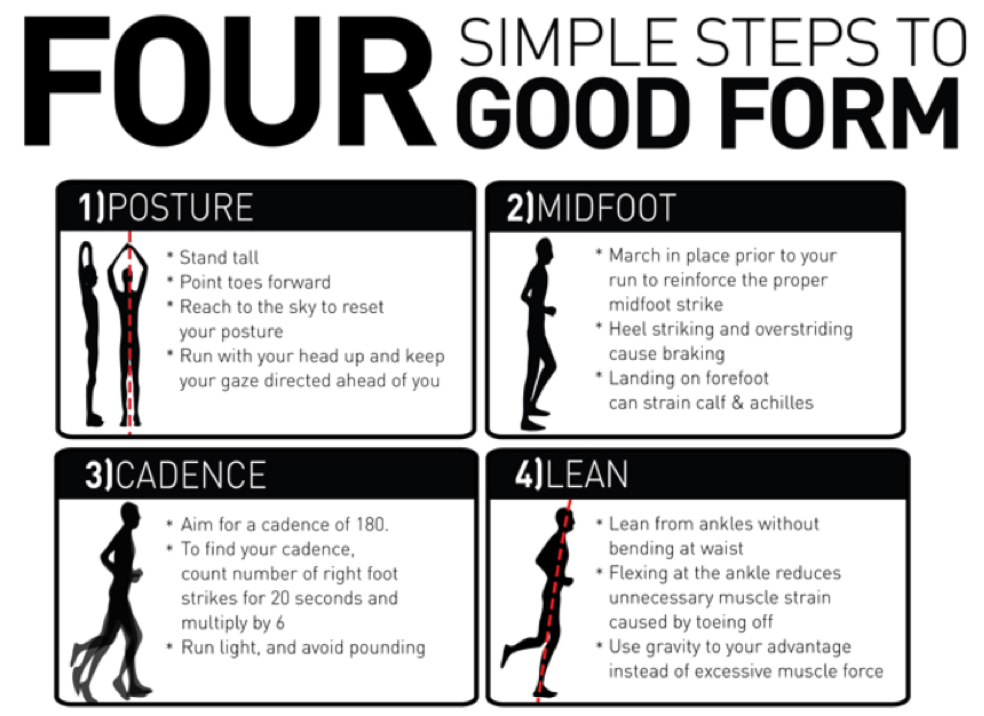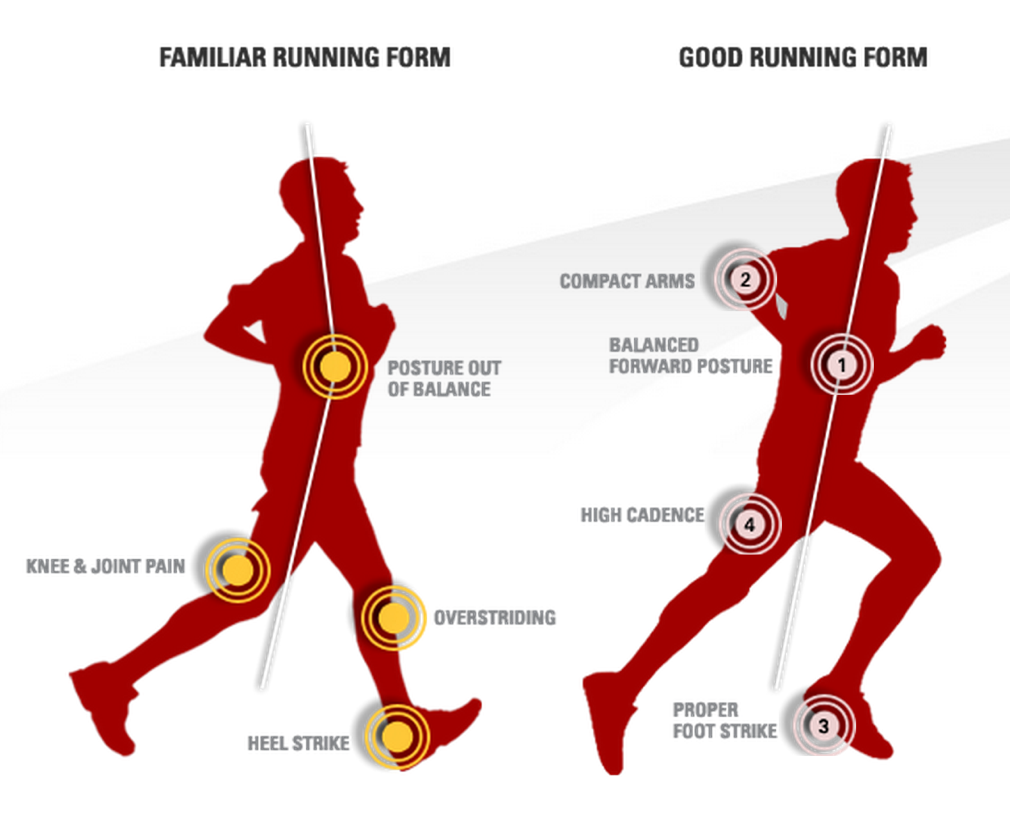|
Okay, let’s start from the bottom up. And when we say bottom, we mean feet. Contrary to popular opinion, landing on the balls of your feet isn’t the be all and end all.Eluid Kipchoge’s(https://www.youtube.com/watch?v=TFQ94-U3nDo) a great example of that as he’s a mid-foot striker. Mind you, the aim of landing is to recoil and spring off with optimum speed and efficiency, which naturally derives from the balls of your feet. Heel landing, on the other hand, which applies to many runners and triathletes, is the most inefficient method. Not only does it slow down movement between landing and toe-off, it potentially increases the likelihood of injury. As for leg position, again it’s individual but, broadly, your shin should be as close to perpendicular as possible when your foot strikes the ground. Foot landing impacts this. Significant heel strikers forge too great an angle; extreme foot strikers, the angles too small. Both scenarios can lead to injury in the opposite limb. The final part of the lower-limb jigsaw is knee position. Ideally your knee should align with the middle of your foot so that when your foot strikes the ground, it’s right beneath your knee. Your knee, on uplift, should also be in front of your hips rather than flaring either way. Then we have the hips. Your torso should be slightly ahead of your hips, so you can more proficiently activate your powerful gluteus maximal muscles. You naturally do this when running uphill, which is why cross-country and fell runners often experience very sore bums’ post-race! Strength exercises: My physio I work closely with has a You Tube video channel, which has many videos to assist with various running ailments Here are some exercises to build strength in your Achilles and calf, these will assist in making your tendons and muscles stronger to help cope with the stresses of running. The library is here https://www.youtube.com/user/bodyleadership/videos Awareness of Body Position is Key Arguably more important than the minutiae of foot, leg, knee and heel position, however, is improving body position awareness or proprioceptors. Simply put, proprioceptors are the sensor in your muscles that govern balance. When you’re injured, these proprioceptors don’t function properly, which can lead to further injury and bad technique. Olympic triathlon coach Darren Smith about this several years back… ‘Every time we land on the ground, we have 0.15secs to land, control and push off in clean alignment, that’s good,’ Smith said. ‘If you’re not aligned, you leach energy because the foot’s structure is all sloppy. It lands and collapses; your knee buckles in; your hip switches. All of this energy is absorbed into the body like a sponge.’ One method to improve this alignment and proprioception, says Smith, is the cleaning-teeth drill, namely you clean your teeth with your eyes closed and on one leg. ‘You then move onto jumping and landing on one foot. Open your eyes and see how your body stands and lands on one foot. Does it collapse? What do you need to do to hold it together?’ It might sound mildly eccentric, but it works: six of Smith’s squad qualified for the 2012 Olympics. Off-Road Benefits You can further improve proprioception with off-road running, which explains why this is such fertile terrain for all levels of runner. ‘When you run off-road, you’re engaging stabilizing and synergetic muscles, not just the main running muscles,’ Rees told us. ‘Every footfall is different. It makes you more aware of your running stride. You’re also much less likely to endure shin splints.’ ‘You’re also more likely to remember what your natural stretch reflex is,’. Your what, you may ask? ‘If you jump lightly and quietly, that’s your natural stretch reflex. Essentially it’s the natural elastic propensity of your muscles to accelerate and decelerate at a certain rhythm. The more sensory feedback your body can retrieve – for instance, from running off-road – the better your body is at recognising and controlling this.’ That includes arm and head position. Again, let’s fall back on Kipchoge for general advice. His head and upper body are so relaxed and still, little energy is wasted. But lower down, there’s a gentle rotation of the core to balance out the rotation of his legs and pelvis. With his upper and lower body working in an opposite rotational pattern, Kipchoge can really engage his core muscles to drive him forward. Cadence Bandwidth
And drive forward he does at a cadence around 180 steps per minute (spm) for a marathon. This is impressive and delivers a twofold benefit: it maintains an efficient stride and ensures he doesn’t overstride, which could lead to injury. It also cuts ground contact time – again, cutting the chances injury. What should your cadence be? Gwen Jorgensen’s former coach, Jamie Tuner, put it best when he said every runner and triathlete should develop a ‘cadence bandwidth’. If you have a wide cadence range – say 160spm for easy running; 166spm for faster running – it really comes in handy when fatigued. “Cadence should be a function of speed – the faster you want to go, the faster cadence needs to be – and you should aim to increase each level’s bandwidth (easy, threshold and 5km/10km pace) by 5-10%,” Turner explains. “An easy-running 160spm, for instance, would rise to 168-178spm. That’s why during speed sessions, focus on a quicker cadence and pushing off the ground with more force, so you’re developing both stride rate and cadence to go faster.” A metronome built into your sports watch is a useful feature to practise running at different cadences. Watches like Garmin’s 735XT and 920Xt can beep you at regular intervals to keep you on cadence track. It is possible to refine your run technique – around 40-60 days and a lot of repetition to rewire your neural map.
0 Comments
Your comment will be posted after it is approved.
Leave a Reply. |
AuthorSimon Brooker is an accredited Multisport and Running Coach based in Brisbane, Australia Archives
July 2022
Categories
All
|





 RSS Feed
RSS Feed